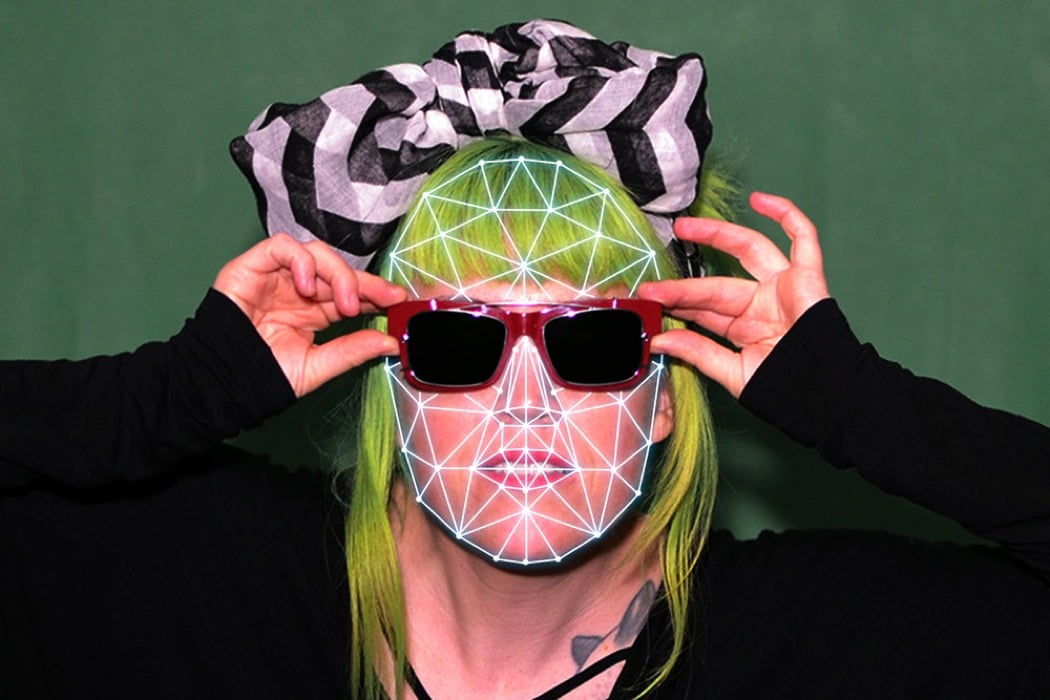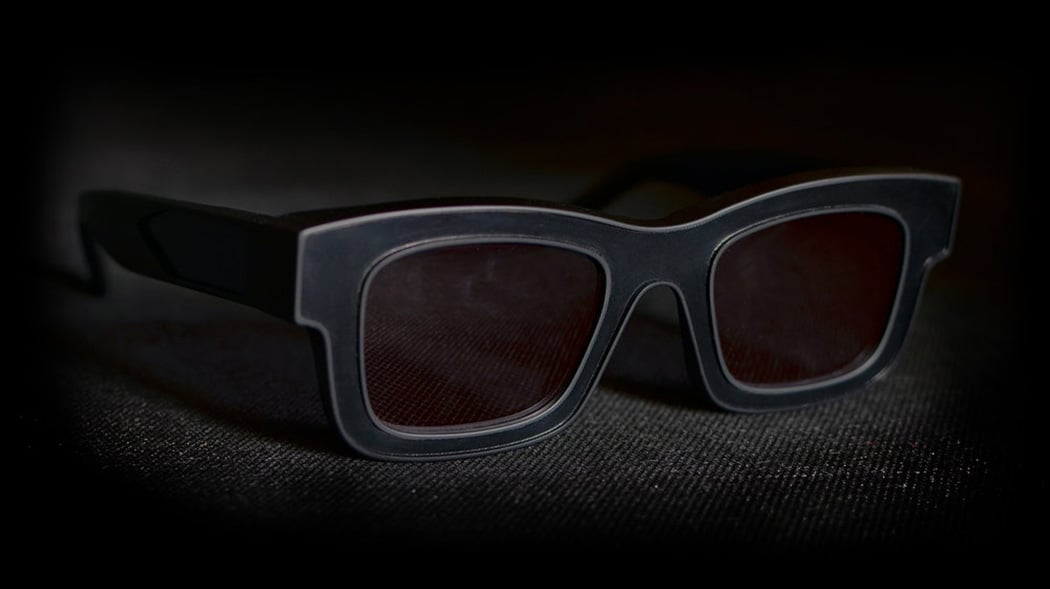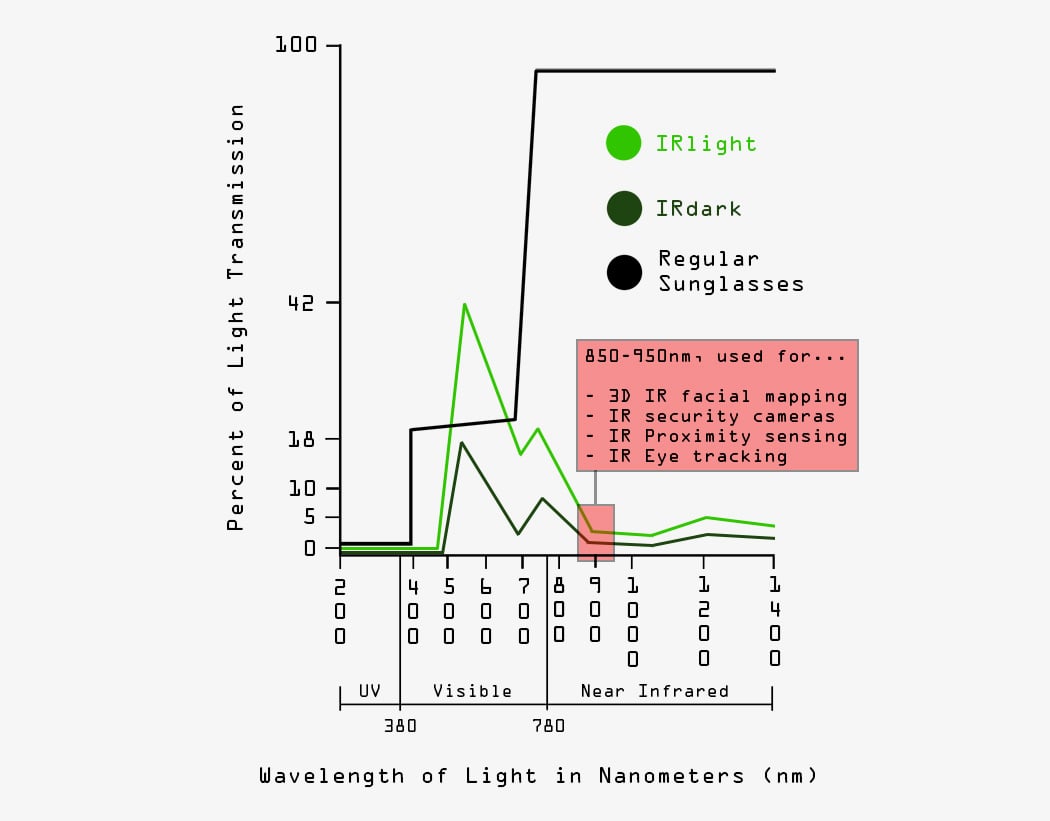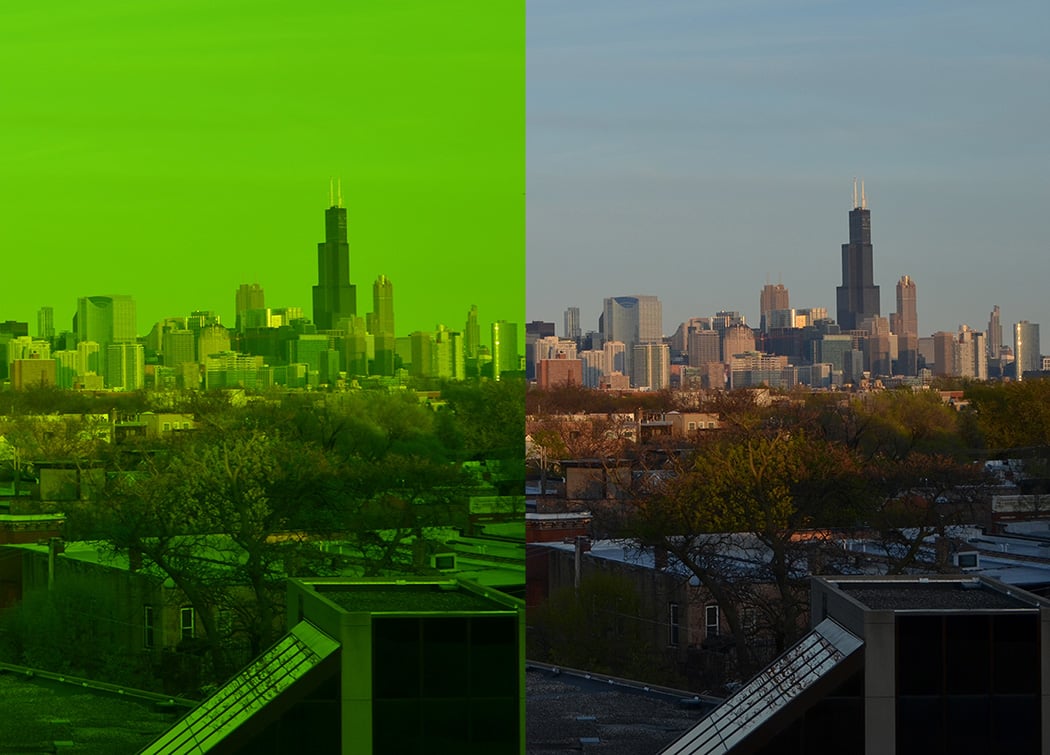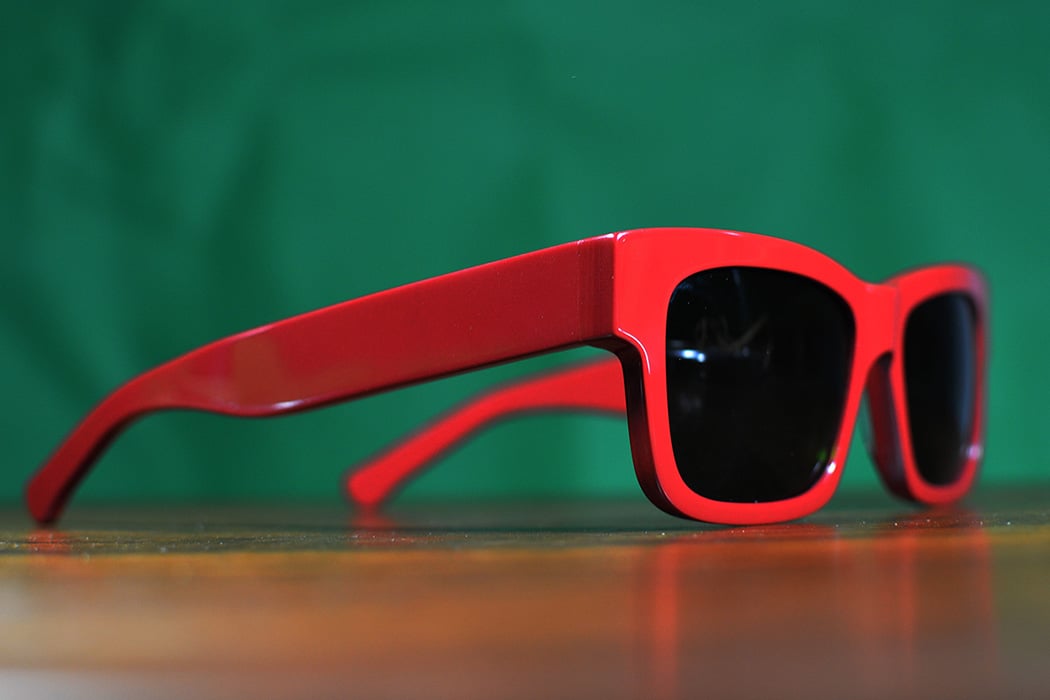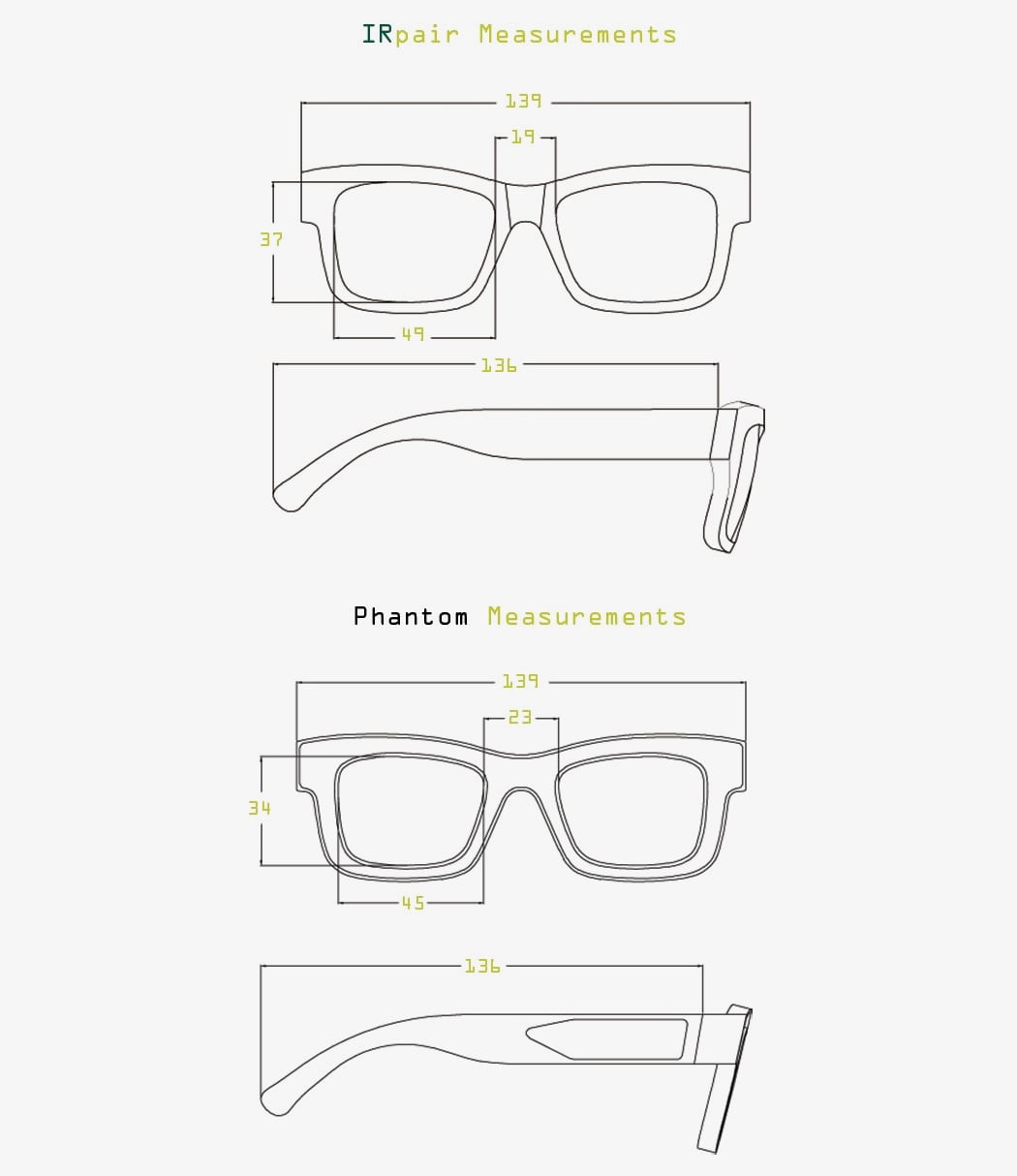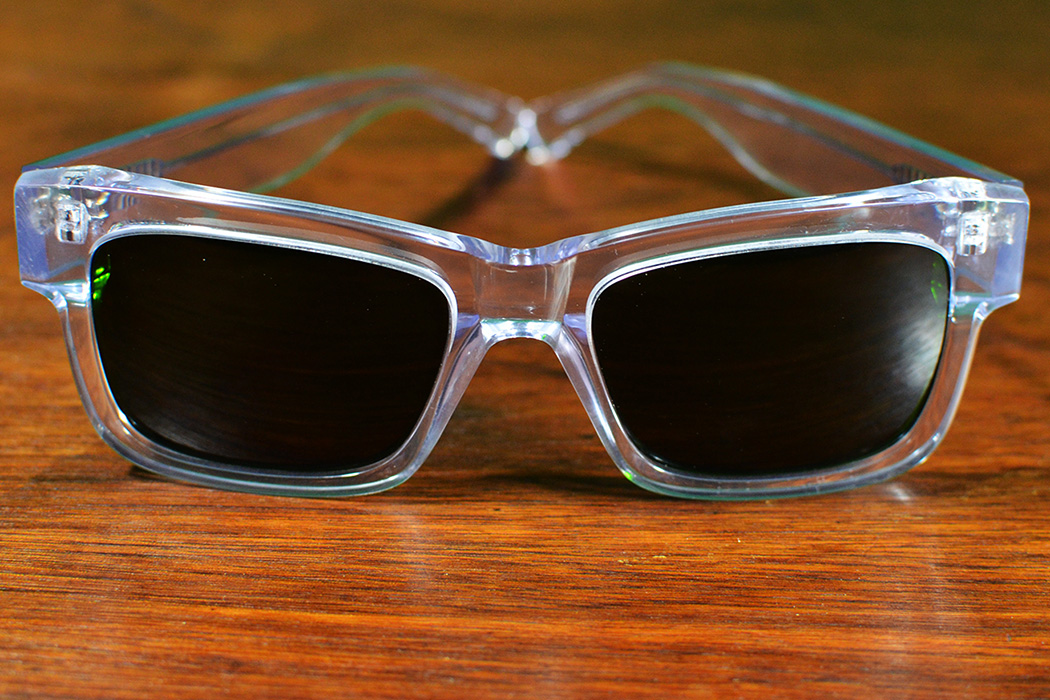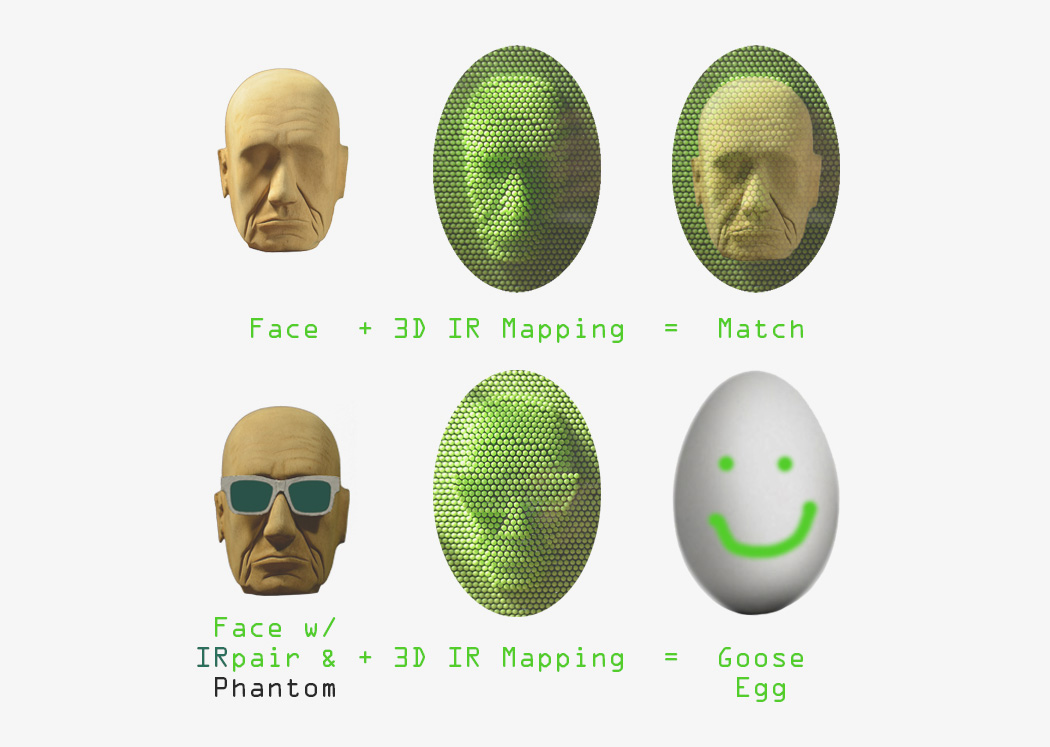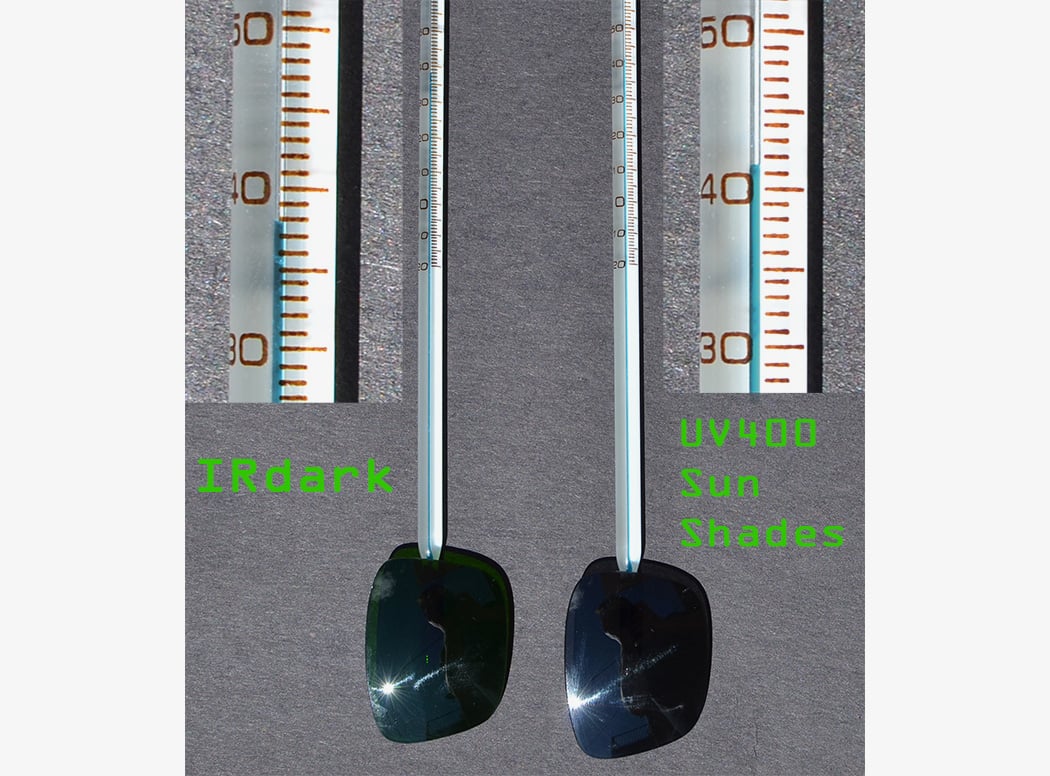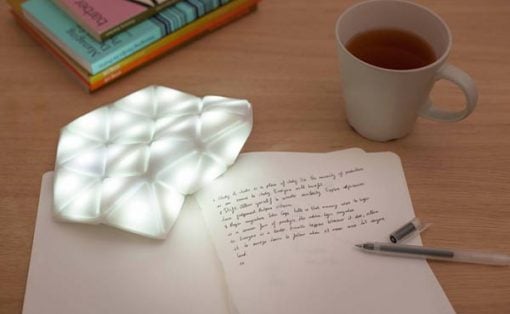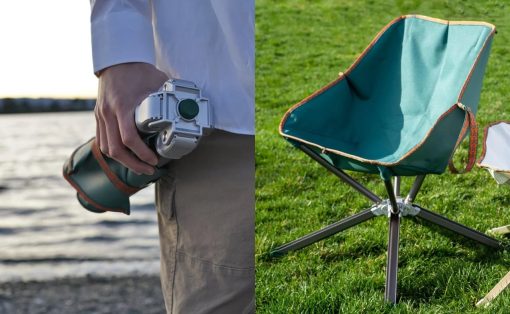https://www.kickstarter.com/projects/reflectacles/irpair-and-phantom-privacy-eyewear
Scott Urban is on a mission to turn eyewear from just a fashion statement to something much more useful. No, his sunglasses don’t come with projectors and cameras inside them… rather, they overcome them. IRpair and Phantom are his two new creations that maintain your identity on facial recognition systems.
IRpair has specially formulated lenses that have the ability to absorb infrared light, which makes them especially useful against practically any sort of camera with an IR sensor in them. Phantom also come with the IR-blocking lenses, but the frame itself also reflects infrared light to pretty much render any facial recognition technology useless. Most facial recognition frameworks rely on an IR blaster to capture your face and the shape of your eyes. These sunglasses make its wearer undetectable to night-vision CCTV cameras, and even your smartphone’s face-unlock feature. In the grander scheme of things, IRpair and Phantom allow you take your privacy back from corporate and state databases that keep tabs on you.
Scott’s obsession with privacy-protecting eyewear started in 2016 with Reflectacles Ghost sunglasses, a pair of spectacles made with reflective material that shines brightly in night-vision cameras and flash photography (your face just looks like a blur of white light), making it practically ideal for people who don’t like having their photos clicked. While Reflectacles Ghost were, and pardon my choice of words, more in-your-face, Scott’s true end-game was to make a discreet pair of privacy glasses that looked just like any other frames.
IRpair and Phantom, in that regard, look just like any other pair of sunglasses. Designed with an acetate body, these frames work perfectly both indoors and outdoors, with a choice between light-tinted lenses that give you visibility indoors and a darker-tinted lenses meant for outdoor wearing. The lenses come with specially formulated optical fibers that completely absorb infrared light in the 850-950 nanometer wavelength. Not only do these lenses block the infrared spectrum, they also block ultraviolet light (UVa, UVb, UVc), as well as visible blue light, making them ideal for wearing in the sun, or even in front of a screen. The blue-light blocking feature also helps prevent fatigue from sitting in front of a screen for too long, and even make your environments appear brighter and crisper by enhancing your perception of depth and reducing the effects of smoke, fog, and haze.
More than just a pair of privacy glasses, IRpair and Phantom are designed to be the spectacles you wear every day. For prescription-glasses-wearers, there is an optional clip-on with the IR-blocking lenses that you can wear when you step outdoors, or when you’re working in front of a computer screen. These special lenses even help by absorbing heat, making your eyes feel cooler in the sun, and giving you a comfortable wearing experience over time.
However, the facial-recognition-blocking ability is IRpair and Phantom’s unique proposition. The glasses help by allowing you to opt out of systems (both regulated and unregulated) that use your face to track your identity without permission. Designed as a discreet solution to a growing problem, IRpair and Phantom give you the upper hand in the battle against ever-advancing facial recognition technology at the price of your privacy…. and yes, you need to take off these glasses every time you want to unlock your phone, but given what’s at stake, is it even sensible to universally use your face as your identity in the first place?
Designer: Scott Urban of Reflectacles
Click Here to Buy Now: $124 $148 ($24 off). Hurry, less than 24 hours left!
IRpair & Phantom – Privacy Eyewear
The first collection of Sunglasses designed to block facial recognition, eye tracking & infrared radiation. Infrared Radiation (IR) in the forms of 3D dot matrix mapping and laser scanning are the most accurate forms of facial recognition technology and they will soon become the most common. IRpair and Phantom maintain your privacy on these systems during both day and night. They also obscure your facial data on 2D IR surveillance cameras in low light environments and block IR eye-tracking. Wear IRpair & Phantom to protect your identity from unregulated facial recognition.
How IRpair Works
IRpair counters facial recognition with the specially formulated IRlenses. These lenses are made with optical filters that allow visible light to pass through, but block infrared radiation from penetrating. IRpair acts as a shield from facial recognition & eye tracking by turning your eye space black to any form of technology using IR for mapping or illumination. Since we cannot perceive IR, our vision remains unchanged.

On left side is an IRlens and on the right is a regular sunglasses lens. When Infrared is used, the IRlens turns black while the regular sunglasses lens becomes clear.
Since IRpair blocks infrared radiation at the lens, 3D IR facial mapping will not be able to read the critical eye measurements for a match during both day and night. Unlike regular sunglasses that become clear in the presence of IR, IRpair’s lenses turn dark black on traditional surveillance cameras using IR in low light situations. Wear IRpair to deny facial recognition access to your eyes.
The following examples of IRpair were made with stock acetate color samples from the manufacturer. For the full production order, IRpair will come standard in a dark black translucent acetate with a glossy finish. Custom colors and acetate properties have been selected as an additional option if funding allows.
How Phantom Works
In addition to the IRlenses, Phantom also uses a frame-applied IR-reflective material to defeat facial recognition. On traditional IR surveillance cameras, Phantom will illuminate around the eye space, denying algorithms the critical biometrics for a match. With 3D IR dot matrix facial mapping, the reflected IR beams from Phantom will distort the facial data to maintain your privacy.

Video from a phone with the visible light on. By not reflecting visible light, Phantom keep you covered.
Phantom remains covert by only reflecting infrared light. Visible light cannot penetrate the black IR-only permeable layer to reach the most retro-reflective material that lies beneath. Phantom may look like a regular pair of black glasses, but they are always reflecting IR from any source.
IRclip for IRpair & Phantom
The IRclip allows you to switch between the IRlenses (IRlight & IRdark). They also make it possible to wear Rx lenses in the frame and select your desired IRlens shade depending on the lighting conditions.

Connect one end of the IRclip to the frame, bend it slightly to fit over the other side and the IRclip is securely attached. This can easily be accomplished while wearing the frames.
A useful combination of IRpair and the IRclip is to have IRlight lenses mounted in the frame and the IRdark lens in the clip-on. This way, you can wear the IRlight lens during the day/night, outdoors/indoors, and when you need extra sunlight protection, clip on the IRdark lens. They work well together.
IRlenses
IRlight and IRdark lenses are made with specially formulated optical filters that absorb the near infrared spectrum which is critical for 3D facial mapping, eye tracking and illumination on average IR security cameras. Any device using IR in the forms of laser or lamp will not be able to obtain the necessary eye biometrics for facial recognition. IRlenses shield infrared radiation from your eyes and maintain your privacy.
IRlenses also filter out the visible blue light spectrum allowing your vision to be more bright, crisp and clear. You will have more perception of depth and you will notice a reduction in the effects of smoke, haze and fog.
Since IR is perceived as heat, IRlenses will help keep your eyes cool and relaxed (no squinting). This is beneficial for people who wear contacts or suffer from dryness of the eyes, even photophobia. IRlenses do the same thing as the BluBlockers of the 90’s, but they also block the near infrared spectrum.
– Blocks 85% of the near infrared radiation spectrum (780-1400nm).
– Blocks UV from 150-475nm (UVa, UVb, UVc, & visible blue light).
– Visible light transmission up to 42%. Can be worn indoors and outdoors during day or night.
– Good for indoor environments scattered with blue light (computers, LED lightbulbs, TVs, phones, etc.).
– Bright vivid yellow/green viewing environment.
– Block 3D IR facial mapping during day & night and traditional 2D facial recognition on cameras using IR for illumination.
– Blocks 95% of the near infrared radiation spectrum (780-1400nm).
– Blocks UV from 150-495nm (UVa, UVb, UVc, & visible blue light).
– Visible light transmission up to 28%. Mainly for outdoor use during the day and some indoor environments.
– Comparable to the darkest sunglasses you have ever worn, while still providing a bright vivid yellow/green viewing environment.
– Block 3D IR facial mapping during day & night and traditional 2D facial recognition on cameras using IR for illumination.
Both IRpair and Phantom are designed to accommodate prescription lenses. Any decent optical shop will be able to cut Rx lenses for the frames. If you want your frames to arrive with your prescription lenses installed, contact me directly to make arrangements (there is not a pledge for prescription lenses). If you do choose to wear IRpair or Phantom with your prescription lenses, you will want to get an IRclip to block infrared from reaching your eyes.
Design and Construction
The design for IRpair and Phantom is thanks to Scott Urban’s 15 year career as a custom wood eyewear creator. The shape and size of this pair looks excellent on a wide variety of facial features … big heads, small heads, women, men, and all the in-betweens.
Details of the Construction
Starting with solid blocks of quality cellulose acetate, the frames are created by the reductive process of CNC machining. This method of manufacturing allows for precise adherence to the design and extremely high durability. The temples have solid wire cores running throughout the temple ends so that you can bend and shape the frames to fit your unique features. Sturdy hinges and a universal bridge provide a gentle and secure fit. You will be able to feel the quality when they are in your hands and on your face.
2D vs 3D Facial Recognition
2D facial recognition uses algorithms to find a match between the subject’s face and an image database of collected faces. It relies on measurements in a 2D plane such as distance between the eyes, nose & lip shape and placement, chin angle, brow space, hairline, etc. In the illustration above, the “algorithm” is shown matching two completely different people simply because their facial features are similar. So far 2D facial recognition is not accurate enough to operate without human involvement.
3D facial mapping uses up to 50k micro-beams of IR to sense and interpret an exact digital replica of the face. Think of it like the old Pinart toy from the 90’s, but only with many thousands more pins. 3D facial mapping is so precise that even identical twins are not able to fool the system. This form of facial recognition allows artificial intelligence to track every face without human involvement.
We are currently led to believe that IR 3D facial mapping is an opt-in system. For example, if you want to log into your iPhone X with Face ID, you choose to give the system your biometric facial data and it will never be shared.
An interesting situation arises when you realize that this technology is so accurate that your face can be scanned at large without consent and given a unique identifier (e.g. a string of numbers).
That data can then be shared across a multitude of platforms to track all movement. Similar to how even when you are logged out of all online services, your internet activity can be stored under a shadow profile.
No Eyes = No Recognition
You cannot unlock Face ID with your eyes closed. For 3D IR facial recognition to work, it needs the biometric data of the eyes. In the 1960’s when Woody Bledsoe developed the first manual-input form of facial recognition, eye measurements were essential to calculate a match. Obviously, this remains true. Facial recognition has relied on human analysis for 99% of its existence. This current push towards automation, algorithms, artificial intelligence, and the use of IR may actually benefit people who value their privacy. All we have to do is block our eyes.
Eye Tracking
Sight is our most intimate sense and eye tracking is being employed for data mining at large without consent. Since the IRlenses do not allow IR to pass through, use IRpair and Phantom to block all forms of IR eye tracking.
Off Axis Lighting
Common security cameras have a ring of IR LEDs around the camera’s lens for illumination. More intelligent lighting schemes have been developed where there is an “infrared flood” light placed “off-axis” to a camera that can perceive the IR flood illumination.
With IRlenses installed, IRpair and Phantom block facial recognition on both traditional IR-ring illuminated cameras as well as off-axis IR lighting setups.
IR is Hot
Although we can’t see IR, we can perceive it as heat. As an experiment, two thermometers were set side by side and placed in direct sunlight for 5 minutes. One thermometer had a regular polycarbonate (UV400) sunglasses lens placed on top of the bulb and the other was covered by the IRdark lens. The thermometer that had the IRdark lens over the bulb was 3 ° C (5.4 ° F) cooler than the regular sunglasses lens. When the regular sunglasses lens was removed to allow direct sunlight, the temperature did not change. When the IRdark lens was removed, the thermometer spiked to the equal temperature of the regular sunglasses. With IRlenses your eyes will remain cooler in sunlight.
The sun emits about 54% infrared radiation, 42% visible light radiation and 4% ultraviolet radiation. As elevation increases, the atmosphere filters out less radiation. These tests were conducted in Chicago with an elevation of 600 feet above sea level. It is very possible that as the elevation increases, so would the temperature difference between regular sunglasses and IRlenses.
Is Infrared Radiation Dangerous?
Laser of the same power in ultraviolet could penetrate any color while the near infrared laser could only penetrate black. This is why you use UV sunscreen for your skin and have UV400 protection on your sunglasses, and also why we need to consider protecting our eyes (black pupils) from IR as well, even if just from the sun’s radiation emissions (54% Infrared).
Infrared is increasingly being used for facial recognition, surveillance, proximity sensing, eye tracking, phones & tablets, artificial intelligence, the internet of things, augmented reality, 5G, military applications, driver-less cars and on. If we could perceive the amount of IR emitting from the modern technology surrounding us, it would be the most spectacular light show.
Click Here to Buy Now: $124 $148 ($24 off). Hurry, less than 24 hours left!

